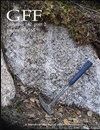Cameral deposits in Paleozoic cephalopods
IF 1.2
4区 地球科学
Q2 GEOLOGY
引用次数: 6
Abstract
Abstract Calcareous cameral deposits have been described in several orthocerid and actinocerid nautiloids. According to the prevailing hypothesis, they were secreted during the lifetime of the animal, either by living tissues in the shell chambers, or by precipitation from the cameral liquid. In the present paper, cameral deposits are described in three species of Carboniferous orthocerid-like coleoid (Order Colorthocerida) from USA. The shell walls and septa in these coleoids are very thin and poorly calcified. In one half of the population of the three species, the septa are completely fragmented and there are no cameral deposits. In the other half of the population, the septa are partially fractioned and their surfaces are covered by well-developed cameral deposits. In contrast to the septa, the cameral deposits do not show any fractioning. To explain the origin of the cameral deposits, the following hypothetical scenario is the most realistic. After the death of the animals, the shells were accumulated on the sea floor and in one half of the population the septa became fully fractioned by the hydrostatic pressure. In shells of another half of the population, the septa were only partially fractioned. The calcifying bacteria entered the chambers of the dead shells through the porous connecting rings and gave rise to the cameral deposits.古生代头足类动物的照相机沉积
摘要:钙质照相机沉积已在几种正尾鲷和放线尾鲷中被描述。根据流行的假设,它们是在动物的一生中分泌的,要么是通过壳腔里的活组织分泌的,要么是通过相机液体的沉淀分泌的。本文描述了美国石炭系三种类似正角鲨的角鲨目照相机矿床。这些胶体的壳壁和隔非常薄,钙化程度很差。在这三个物种中有一半的种群中,隔膜完全破碎,没有照相机沉积物。在另外一半的人口中,隔层是部分分离的,它们的表面被发育良好的照相机沉积物覆盖。与隔层相反,照相沉积物没有表现出任何分馏作用。为了解释照相机矿床的起源,下面的假设情景是最现实的。动物死后,贝壳堆积在海底,其中一半的隔层在静水压力的作用下完全裂开。在另外一半人的壳中,隔层只被部分分割。钙化细菌通过多孔的连接环进入死贝壳的腔室,并产生照相机沉积物。
本文章由计算机程序翻译,如有差异,请以英文原文为准。
求助全文
约1分钟内获得全文
求助全文
来源期刊

Gff
地学-地质学
CiteScore
2.80
自引率
10.00%
发文量
11
审稿时长
>12 weeks
期刊介绍:
GFF is the journal of the Geological Society of Sweden. It is an international scientific journal that publishes papers in English covering the whole field of geology and palaeontology, i.e. petrology, mineralogy, stratigraphy, systematic palaeontology, palaeogeography, historical geology and Quaternary geology. Systematic descriptions of fossils, minerals and rocks are an important part of GFF''s publishing record. Papers on regional or local geology should deal with Balto-Scandian or Northern European geology, or with geologically related areas. Papers on geophysics, geochemistry, biogeochemistry, climatology and hydrology should have a geological context. Descriptions of new methods (analytical, instrumental or numerical), should be relevant to the broad scope of the journal. Review articles are welcome, and may be solicited occasionally. Thematic issues are also possible.
 求助内容:
求助内容: 应助结果提醒方式:
应助结果提醒方式:


